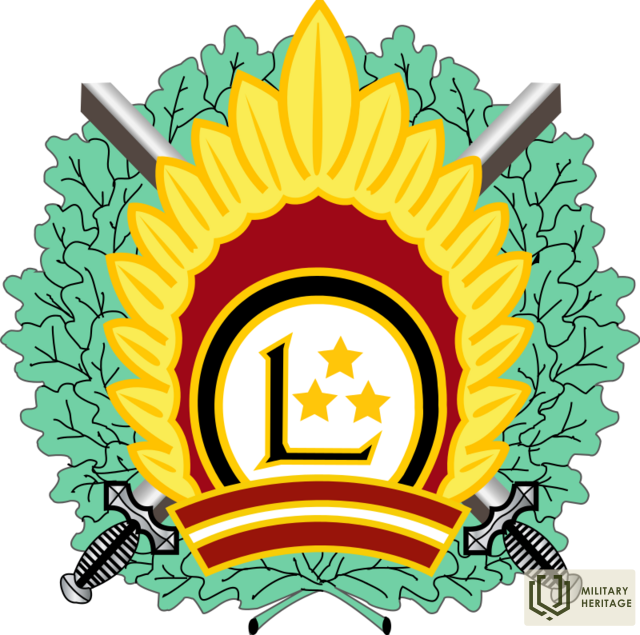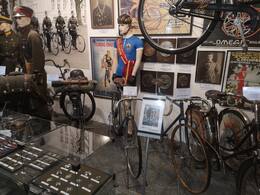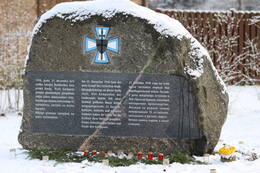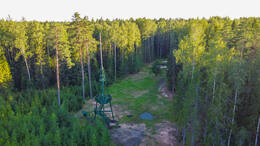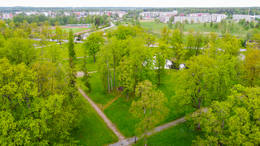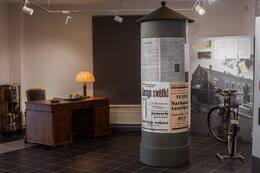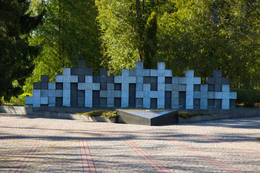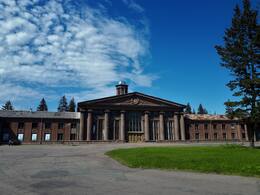Latvian Army
I Wars of Independence, Independence of the Baltic States, II WW2
On January 5, 1919, the first largest national military unit was established - the Separate Latvian Battalion under the command of Lieutenant Colonel Oskars Kalpaks. This unit, which was transformed into a brigade in March, together with the Northern Latvian Brigade, organized in Estonia and commanded by Colonel Jorgis Zemitans, formed the Latvian Army. The newly formed army grew and hardened in the battles against the Bermontians near Riga and Kurzeme, as well as in the battles against the Bolsheviks on the Latgale front.
One week after the end of World War I and the conclusion of the Compiegne armistice on November 11, 1918, the establishment of an independent Latvian state was proclaimed. The new caretaker government had hoped to do without a regular army, as no one was going to attack. On November 13, 1918, Soviet Russia revoked the Brestlitov Treaty of Peace, which had renounced Baltic territory in favor of Germany, and began moving west. Expectations that the German army would fulfill its commitment to defend Latvia against the Bolshevik invasion did not materialize.
Meanwhile, troops loyal to the Provisional Government of the Republic of Latvia were formed in Riga. In the spring of 1919, the Latvian Armed Forces consisted of the Landeswehr (German-Baltic National Guard), the Northern Latvian Brigade and the Southern Latvian Brigade. On July 10, 1919, General Dāvis Sīmansons united the two brigades, becoming the first Commander-in-Chief of the Latvian Army. This day is considered to be the day when the Latvian army was established.
In 1919, the Latvian army was rapidly armed and developed, and armaments and equipment were received from England, Poland and other countries. At the beginning of 1920, about 52,000 soldiers served in the Latvian Armed Forces. The War of Independence ended on August 11, 1920, when a peace treaty was signed with Soviet Russia. Immediately after the War of Independence, the Latvian army began to move to a peacetime state. The Latvian army consisted of four infantry divisions with three infantry regiments and an artillery regiment each. The infantry regiments were numbered and named after Latvian cities. The Latvian army also had a navy consisting of the flagship Virsaitis, a submarine division with two submarines "Ronis" and "Spidola", as well as a mine division with two minesweepers "Imanta" and "Viesturs" and several support ships.
The composition of the army was formed on the basis of the general military service to which all Latvian citizens were subjected. Until 1931, the service period was 18 months, later it was shortened to 12 months for infantry, 15 - for other weapons classes. The army and navy were administered by the Ministry of War. The army commander was in charge of the army, who was responsible for training and preparing the army.
On June 1, 1940, there were 30,843 men in the Latvian army. On June 17, 1940, during World War II, Soviet troops took control of all of Latvia and Estonia. The Latvian army was gradually disbanded, retiring in reserve, arresting and deporting Latvian soldiers. On September 27, 1940, the position of the Minister of War of Latvia was abolished, but on October 9, 1940, the position of Commander of the Latvian People's Army was abolished.
On June 17, 1989, the founding conference of the Latvian Riflemen's Association was held in the Great Hall of the State University of Latvia in Riga. After which, in a few weeks, more than 500 former soldiers joined the Latvian Riflemen's Association. In the autumn, branches and groups were established in Jelgava, Tukums, Liepaja, Bauska, Balvi, Livani, Moscow and elsewhere. Active work is beginning on the creation and development of laws, regulations and various documents that will be necessary for the establishment and existence of the army.
On September 10, 1991, a law on compulsory military service was passed. Due to this law, all male citizens of Latvia, aged 19-50, must perform compulsory military service. Shortly after the adoption of this law, on November 11, the Brothers' Cemetery is given the first oath of soldiers since the restoration of Latvia's independence.
More information sources
1. 100 events in the history of Latvia. People and processes 1918-2018. JSC “Latvijas Mediji”, 2018.
2. The blizzard of souls. Digital Museum. Available: https://www.dveseluputenis.lv/lv/laika-skala/notikums/105/sarkanas-armijas-iebrukums-latvija/ [accessed: 08.05.2021.].
3. National Armed Forces website. Available: https://www.mil.lv/lv/par-mums/vesture [accessed 08.05.202
Related objects
Exposition of military bikes in the Bicycle museum in Saulkrasti
The Bicycle Museum is located in Saulkrasti not far from the A1 highway and the railway station Pabaži, near the White Dune. Museum’s collection is made up of technically the most interesting examples of bicycle development history in Latvia. It is the largest bicycle collection in the Baltics with about 60 bicycles made and used in Latvia, including army-type bicycles. In the beginning of the 20th century many armies started to widely utilise the availability and benefits of bicycles. Special bicycle units were formed because of their mobility. Bicycle units were able to gather intelligence and launch unexpected attacks more easily, and were more mobile than regular infantry when it came to operations over a wide area. After World War I the Latvian Army...
Monument to the first battle for Latvia's independence
Atroadas, Inčukalns, Atmodas Street 2.
On July 3, 2016, a monument to the first battle for Latvia's independence, dedicated to the Latvian National Guard (Die Lettländische Landeswehr), was unveiled. sides. Eižens Upmanis, the chairman of the Brothers' Cemetery Committee, concluded at the time that this could be the historically first monument to the combined Latvian and Baltic forces in the battle memorials...
Latvian Army Summer Camp in Litene
The Latvian Army Summer Camp in Litene is located in the forest in Litene parish, near the Pededze River. The beginnings of the Litene Camp can be traced back to 1935 when the construction of a summer camp complex for the Latgale division of the Latvian Army was started. From May to autumn, several thousand soldiers learned combat tactics and shooting skills in Litene. In the summer of 1941, Latvian Army officers were arrested by Red Army and NKVD troops at an army summer camp in Litene. Several officers were shot on the spot, while others were deported to Siberia. On 14 June 1941, at least 430 officers were arrested and deported to Siberia in the Litene and Ostrovieši camps about 10 kilometres from Litene. The only historical building that has...
Latvian military aviation aerodrome
Located in the territory of Vecgulbene manor - in the historical center.
In the interwar period, the garrison of the Latvian Army was located in Gulbene, where the 7th Sigulda Infantry Regiment Battalion was stationed. Aerodromes are especially important in places where important railway and road junctions have been established. In 1937, a newly established unit of the Aviation Regiment was stationed in Gulbene, which became the 6th Division of the...
Exposition "Latvian Army in Pļaviņas in the 20th Century"
Located at Odzienas Street 2, Pļaviņas.
The permanent exposition "Latvian Army in Pļaviņas in the 20th Century" can be seen.
...Memorial Wall of Pain
Artrodas Litene cemetery.
On June 14, 2001, the memorial “Wall of Pain” created by architects Dina Grūbe, Benita and Dainis Bērziņš, stonemasons Ivars Feldbergs and Sandra Skribnovskis was unveiled in Litene Cemetery, it symbolizes the resting place of the soldiers killed in 1941. In October 1988, the ashes of 11 officers killed in June 1941 by the Soviet Army were found in the territory of the former...
Spilve airport
Located in Riga, Pardaugava, Spilve meadows near Ilguciems.
Spilve is famous in the history of military heritage for the large-scale battle of Spilve in the 18th century. and Spilve Airport. Beginning in the 20th century, it was used to test aircraft, but in World War I it became a witness to the history of Latvian aviation.
...Latvian War Museum
The Latvian War Museum is located in the Old Town not far from the Freedom Monument in a historic defence building called the ‘Powder Tower’. There are 11 exhibits in the museum. There are various weapons, documents, uniforms, awards, badges and other items detailing the everyday life of a soldier in war. The Latvian War Museum is one of the oldest museums in Latvia. Its origins can be found in World War I. Museum’s collection was made up mainly of personal items of soldiers or items found on battlefields. After Latvia gained its independence the main goal of the museum became to create an exposition on the military history of Latvia and the active role of the population in protecting their land. In 1937 the museum was expanded and was...
Treasure House of the Free State
A unique exposition on the history of military and civil awards of the first free state of Latvia, as well as various organizations related to the activities of state and civil organizations in the period from the Latvian War of Independence to the Second World War.
Several hundred different historical evidences from Latvian and foreign private collections are exhibited in the exhibition house, covering the period from 1918 to 1940, revealing the pages of...
Preiļi Museum of History and Applied Arts exhibition "Jāzeps Baško - air coachman"
It is located in Preiļi 1st primary school premises.
The exhibition "Jāzeps Baško - air driver" was created in 2014 and is dedicated to the 125th birthday of the outstanding local man, aviator, commander of the "Iļja Muromec" squadron, organizer of the Latvian Air Force, general Jāzeps Baško and the 100th anniversary of World War I. The exhibition of the museum's collection is designed as a design object - a 6-fold reduced model of...
Exhibition "Latvian Army in Pļaviņas in the 20th Century"
The exhibition features information stands with historical photographs, maps, and information about the establishment of the Latvian Eastern Front Headquarters. The composition of the exhibition is made up of interior elements corresponding to historical events.
The exhibition “Latvian Army in Pļaviņas in the 20th Century” is located in Pļaviņas, Odzienas Street 2, a historical building where the headquarters of the Latvian Eastern Front was located in...
Latgale Artillery Regiment Army Barracks
The Latgale Artillery Regiment Army Barracks were built as a three-story modern building according to the project of architect Verners Vitands in 1931. This monolithic reinforced concrete building was one of the first in Latvia. They have survived, located in the territory of the Krustpils Manor, next to the castle park. Today, the three-story building that has survived is the unmanaged property of the Jēkabpils municipality. Window openings without windows, entry into the building is not possible, the building can be viewed from the outside. The municipality has carried out roof replacement work. In the future, it is planned to renovate the building by placing various organizations there, and hand it over to entrepreneurs for use.
...Riga Garrison Army Tent Camp
Now there are bushes and thickets here, but in the thirties of the last century, the Riga garrison army summer camp was located here. In some places you can still see what look like rectangular ramparts. In these places there were soldiers' tents, arranged in four long rows, with small streets in the middle. At the ends of the rows stood the logos of the garrison units - they were cast from concrete, but the ornaments and inscriptions were made of small, colorful stones. The ramparts around the tents were necessary not only to retain moisture, but also for military purposes. If landing troops entered Mangaļsala, they would be used as trenches under the cover of which to protect the territory from the enemy. Although real military training was taking place here, a...
Army town
In this area, in the late 1920s and early 1930s, the Latvian army built an army camp for officers and soldiers who worked on Mangalsala. Later, the camp, along with the Mangalsala military base, became the property of the Soviet Union. Civilians without a certain status lived here, but later social apartments were created for low-income people. On the right side there was a football field and small gardens, but over time they turned into meadows and swamps. Later, private houses and a car service appeared here. Until the 1960s, Mangalsala was not part of Riga at all, but part of Mangali parish. At that time, people here were engaged in fishing or worked at the army base, because agriculture was practically impossible – the arable land area on...
Related stories
For the first Commander-in-Chief of the Latvian Army David Simanson
The essays of the book "Latvian Army Commanders" convince that history is significantly influenced by specific people. Although at the epicenter of the most important historical events for a short time, the true Latvian patriots, with their rich military experience, managed to accomplish a lot in the formation and strengthening of the Latvian army and the turn of historical events.
This story is about the first commander-in-chief of the Latvian army, David Simanson (1859-1933).
In memory of Pēteris Radziņš, General of the Latvian Army, two-time Knight of the Lāčplēsis War Order
General Pēteris Radziņš, born in Lugka Parish, Valka District, in a simple farmer's family, where he learned to do field work. He was a very smart young man, after graduating from school he decided in favor of the war and it started his army rescue of Latvia from Bermont's troops. P.Radziņš was one of the most outstanding officers of the Latvian Army and was awarded with numerous Latvian and foreign orders and memorials.
Army presence in Mangalsala
I remember vivid impressions about the presence of the Latvian army in Mangalsala. The forts as well as the reinforced concrete fortification built by Sapieri are described. Memories describe the daily life of soldiers, the rhythm of life and illustrate the environment in Mangalsala. Visit of soldiers of Mangalsala and Latvian army
Memories of the beginning of the establishment of the War Museum
The narrator describes the conditions under which the War Museum was established. Problems and collection work are mentioned.
United Aviation Festival - a real national holiday
The narrator describes one of the most popular and widely attended events in Latvia - the Aviation Festival in Spilve. Describes the course and scope of the festival. The popularity of aviation in Latvia is emphasized.
Par Sudrabkalniņa atklāšanas svētkiem
Atmiņu stāsta izvilkums no ģenerāļa Jāņa Baloža uzrunas Sudrabkalniņa pieminekļa atklāšanas dienā. Pilnā tekstā ir atstāsts par atklāšanas pasākuma norisi, Valsts prezidenta Kārļa Ulmaņa un ģenerāļa Jāņa Baloža uzrunas. Atmiņas izvēlētas, jo spilgti parāda to kādā stāvoklī bija Latvijas armija, kura cīnās Sudrabkalniņa apkaimē.
About Daugavgriva fortress
The narrator describes an event in the Daugavgrīva fortress during World War I, when it was bombed by an air force in the German army. The fortress was one of the strategic objects that remained important until the end of World War II.




